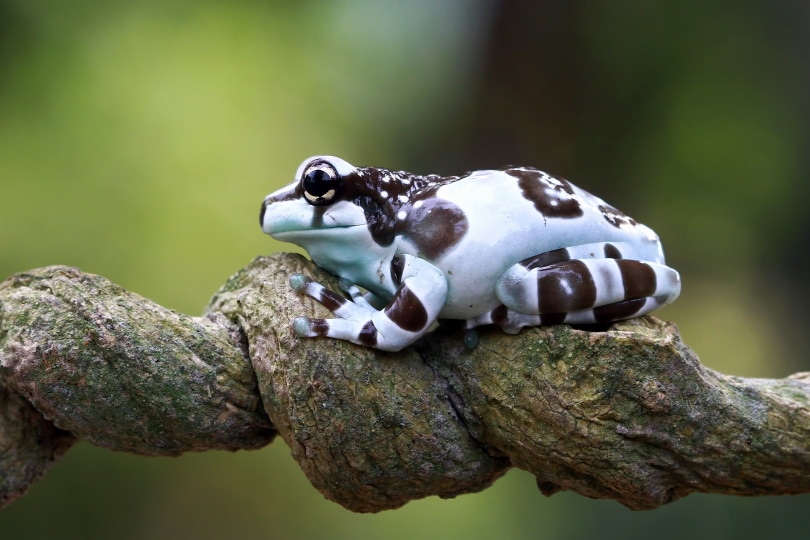

The Amazon Milk Frog is nature to the Amazon Rainforest in South America. They are also called the Mission Golden-Eyed Tree Frog due to their copper-colored eyes that stand out among the other frog species.
They are relatively large as far as frogs go, reaching about 2.5 to 4 inches in length. All adults are a light grey color with darker banding across their bodies. Their skin usually starts as smooth and becomes bumpier and more worn as they age.
Because they are found in highly humid environments, they are a bit complicated to keep in captivity. While they are generally easy frogs with a docile temperament, they require a great deal of space and humidity to thrive. They also require more attention than many frog species.
Quick Facts about the Amazon Milk Frog
| Species Name | T. resinifictrix |
| Family | Hylidae |
| Care Level | Low |
| Temperature | 65 to 85 degrees Fahrenheit |
| Temperament | Docile |
| Color Form | Light grey |
| Lifespan | 8 years |
| Size | 2.5” to 4” |
| Diet | Small invertebrates |
| Minimum Tank Size | 20 gallons |
| Tank Setup | Plenty of climbing room |
| Compatibility | Others of the same species |
Amazon Milk Frog Overview
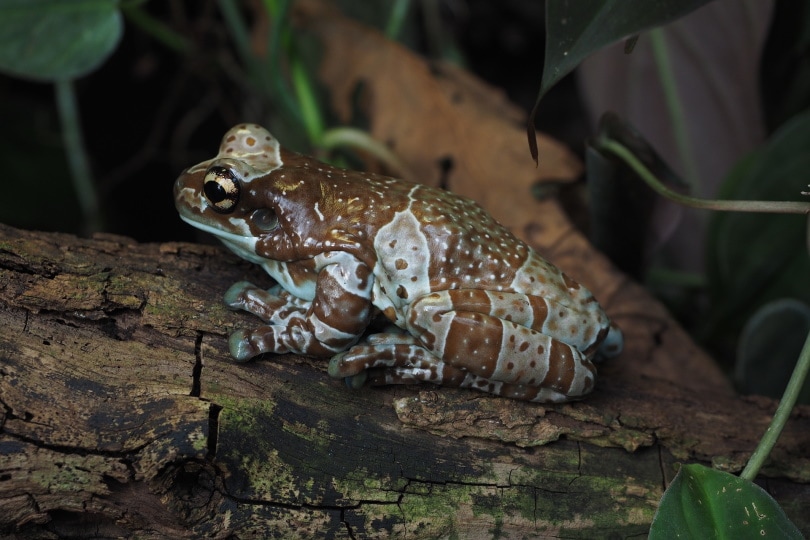
Many people enjoy keeping Amazon Milk Frogs. They are hardy and easy to find. Many are bred in captivity, so they are inexpensive and adaptable. Despite this, we do not recommend them for beginners. Their care is similar to that of other frogs, but they require more humidity and specific tank settings. Therefore, they can be a bit more difficult to keep if their tank is not set up appropriately.
That said, their overall care is uncomplicated. If you have kept frogs before, then you likely know what to expect from this frog. They are often quite enjoyable to watch and easy to take care of for those experienced.
How Much Do Amazon Milk Frogs Cost?
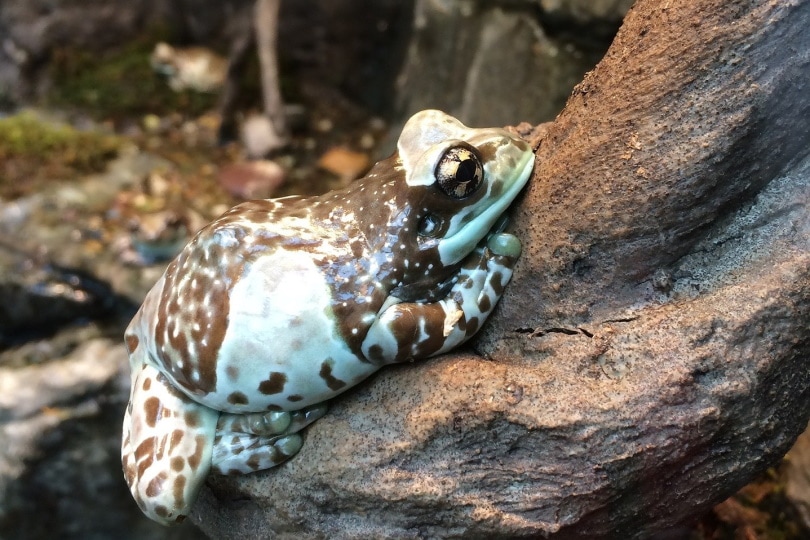
These frogs usually cost around $45 to $50. This is average as far as frogs are concerned. Many of them are now bred in captivity, so you can likely find a breeder near you. This is a better option than purchasing from a pet store, as it ensures that the frogs are well taken care of and have to undergo less shipping. There is no telling where pet stores get their frogs from, which often means that they may have been shipped from far away.
This is especially true for chain pet stores, which often get their animals from only a few breeders around the country. These frogs do ship well, but it is always best for them to avoid the stress where possible.
Breeders may be cheaper because you’re cutting out the middle man. If you purchase from a breeder, ask to see where the adult frogs are kept, as this is usually a good indication of the overall care that the animals receive. You can also ask what the frog’s current diet is, eliminating some of the guessing that you usually have to do at the beginning.
Be sure to purchase captive-bred frogs. While wild-caught frogs are not as common as they once were, they are still around. They are not as adaptable to living in a tank and often have to undergo a stressful shipping process.
We also don’t recommend purchasing younger frogs. While these are cute, they are not as hardy as frogs over 2” and may not survive the transportation and acclimation with their new home. It is usually best to wait until they are a bit larger to survive the transition.
Typical Behavior & Temperament
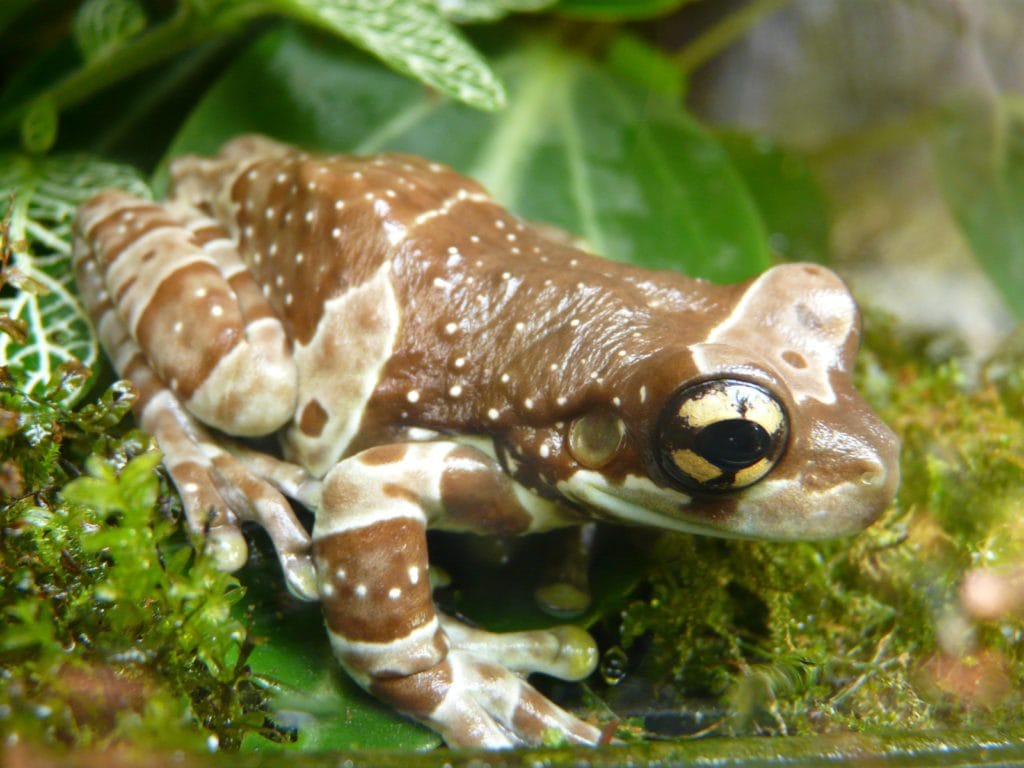
Amazon Milk Frogs typically thrive in groups. Sometimes, the males may harass the females for mating purposes, but this only occurs occasionally. Plus, not all males partake in this. For the most part, they exist peacefully in groups and don’t require much extra care when kept together.
These frogs are nocturnal animals. They will sleep for much of the day. They will find a nice hiding spot during this time, such as in hollow pieces of bark or behind foliage. This prevents them from getting eaten in the wild, though they don’t have to worry about that in captivity.
The best time to observe them is at night, as this is when they are most active. They can be entertaining to watch. However, if you aren’t awake in the evenings or go to bed early, you may want to choose a different, diurnal pet.
That said, they will wake during the day if you mist or feed them. Generally, we recommend waiting until the evening to do this, however. It is best to let them keep their natural sleep cycle.
Appearance & Varieties
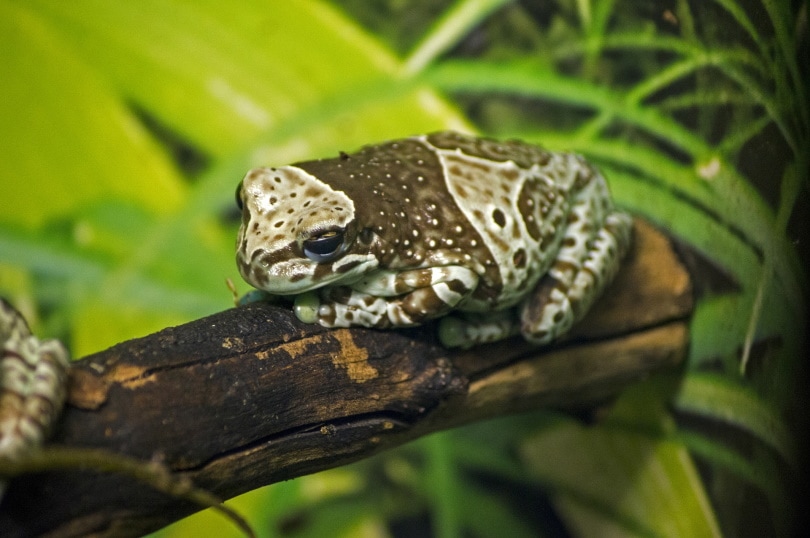
These frogs are relatively large compared to other species. They can reach up to 4.0 inches, though some are as small as 2.5 inches. For this reason, they need a bit more room than most other frogs. It is vital to ensure that they have enough space (and that you have enough room in your house for these frogs before adopting them).
All adult frogs are a light grey in color, but they do vary somewhat in shade. They also have large, black or brown banding. Juveniles have contrast between the bands, but adults are usually less striking in color. They also have smoother skin than adults. As these frogs age, they are likely to develop a bumpy texture and rougher skin.
They are called “milk” frogs because of the milky fluid that they create when stressed.
How to Take Care of Amazon Milk Frogs
Habitat, Tank Conditions & Setup
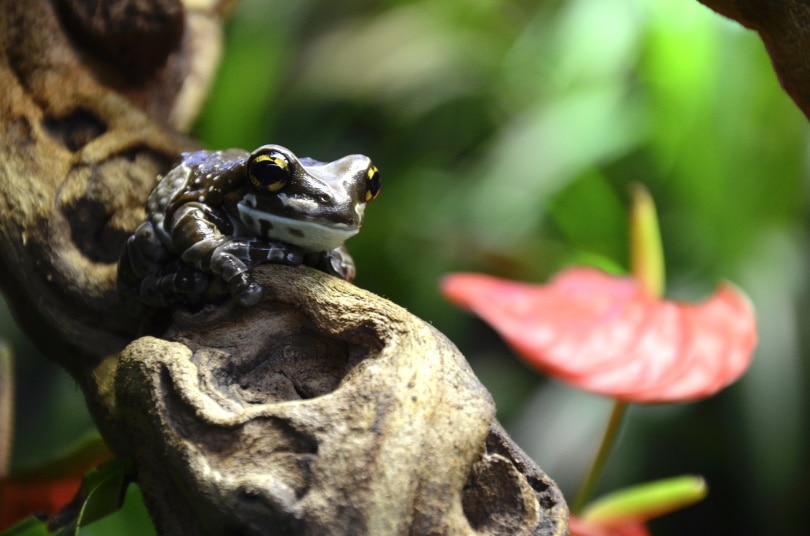
For housing one or two adult frogs, you need a 20-gallon aquarium. With these few frogs, the exact shape of the aquarium doesn’t matter much. If you want to house a group of up to five, then you need a larger enclosure that measures at least 24” x 18” x 24”. Juveniles need a generally smaller enclosure, usually around 10 gallons. We recommend keeping them in a smaller enclosure so you can find them easier, as they tend to get lost when put in a more extensive habitat.
These frogs require plenty of ventilation, so we recommend using a screen cover that provides plenty of airflow. These frogs need plenty of humidity and airflow, which can be challenging to accomplish.
You can use a substrate that is easy to clean, such as wet towels or sphagnum moss. Paper towels are a perfectly acceptable substrate, but many people may choose moss to give the tank a more “natural” feel. These frogs don’t necessarily need substrate, but you will need to spot-clean the bottom of their enclosure if you do not provide them with some.
The frogs themselves will rarely want to hang out on the ground. For this reason, you will need to provide them with plenty of different perches, such as bamboo poles, PVC pipes, and cork bark. PVC pipe works surprisingly well and is extremely inexpensive. You can also use live plants, but ensure that they are sturdy enough to hold these larger-than-average frogs.
In the wild, these frogs tend to spend most of their time around water-filled tree holes. This is also the area that they breed in. In captivity, you can mirror this natural environment with a big water dish. You will need to change the water at least once a day and use only tap water that you have treated to remove the chlorine and chloramines. Frogs can soak up things through their skin, including harmful chemicals from the water.
Every few weeks, the enclosure will need to be scrubbed thoroughly with hot water to help remove any built-up waste. You should not use soap, as this can be dangerous for the frogs.
These frogs need plenty of humidity. Technically, a level of 50% to 100% is suitable. However, they thrive best when the humidity is kept at the higher end of this range. You will need to mist the cage daily to increase the humidity to an appropriate level. You should measure the humidity regularly.
During the day, the enclosure should be kept at around 80 to 85 degrees Fahrenheit. However, parts of the tank should stay at around 70 to 75 degrees Fahrenheit. The tank should not all be the same temperature, as the frogs should be allowed to move to cooler or warmer areas as they need. At night, the temperature can safely fall to 65 degrees Fahrenheit. Use incandescent light bulbs as necessary, as well as an accurate thermometer. Keep an eye on the temperature and adjust your setup as necessary.
These frogs do need UVB light, like most frog species. You can add a UVB bulb to their enclosure to fulfill this need. Replace the bulb annually, even if it still looks okay.
Do Amazon Milk Fogs Get Along With Other Pets?
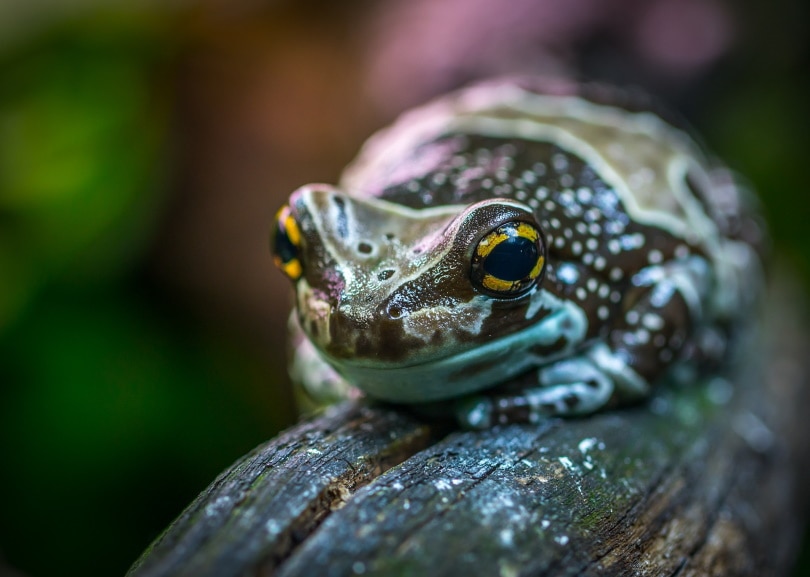
While these frogs do get along with others of the same species, you should not mix them with other frogs. Often, they will eat or be eaten by the other frogs. Of course, lizards and similar animals also eat them, so they shouldn’t be kept with these animals either.
In general, it is best to keep these frogs alone.
What to Feed Your Amazon Milk Frogs
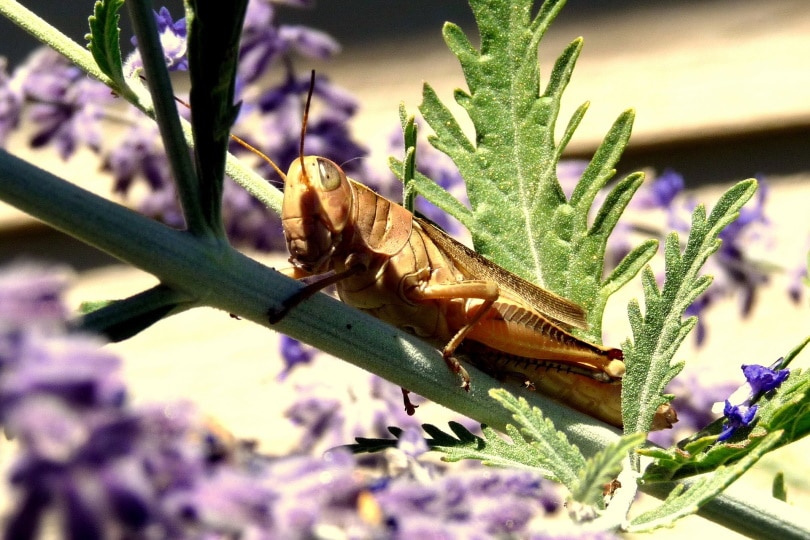
Like most frogs, the Amazon Milk Frog eats many different invertebrates. In general, crickets should make up the majority of their diet. You can also use house flies, cockroaches, and earthworms in their diet on a regular rotation. Juveniles should be provided with food daily, though adults should only be fed about two to three times a week.
Offer around three to 10 food items with each feeding, depending on the size of the items. They will need fewer large crickets than house flies, for example. Use your best judgment.
These frogs will need a high-quality vitamin and mineral supplement, as they don’t often get everything that they need from their captive diet. Choose a supplement that is free from phosphorus but contains vitamin A and D3. Use this supplement for every feeding for juvenile frogs. For adults, add the supplement every other feeding.
Keeping Your Amazon Milk Frogs Healthy
These frogs are generally healthy as long as you keep their tank conditions correct. The most common health problems come from a lack of specific vitamins and minerals. However, if you’re using a supplement, this won’t be a problem. For instance, metabolic bone disease is common in frogs that don’t receive enough vitamin D and calcium. Their body is unable to grow and upkeep their bones properly, which leads to deformations and brittle bones. These frogs eventually cannot lift their own weight or will break their legs with a simple hop.
Despite their larger-than-average size, they should not be handled regularly. Frogs that are over 2” can be handled with extreme care. However, it is essential to remember that their skin soaks up everything that it comes into contact with, including any chemicals that you may have on your hands. Soaps, perfumes, and even lotions can be dangerous to these frogs, so they should be avoided.
Only handle your frogs if it is necessary, such as when you’re cleaning their tank. Wash your hands after you handle the frogs, but not before. You want to keep yourself safe from any potential bacteria that the frogs are carrying. However, you don’t want the chemicals in your hand soap to harm the frog.
It is vital to keep up with proper cleanliness standards. Otherwise, bacteria can become a problem, which can make you and your frogs sick. On top of changing the water daily, you should spot-clean the tank every day. Remove dead food items that are not being eaten and other waste from the enclosure. Give it a good scrub once a week to remove any hidden waste material and condensation build-up.
Frogs should be inspected weekly to ensure that they are in good health. A good time to do this is during your weekly cleaning session, as you may need to remove the frogs for cleaning, anyway. Check perches in the aquarium for waste, and clean them as necessary.
Breeding
In captivity, these frogs are generally easy to breed. They bred naturally when provided with a healthy environment and plenty of food, though that doesn’t mean that you should overfeed them. They need a water-filled area to deposit their eggs. In the wild, this is often a water-filled tree hole. You can use a bowl of water to mirror these conditions.
Some breeders proclaim that you need to cycle your frogs through a rainy season for them to breed. However, many frogs will also breed regularly throughout the year without any change in temperature or humidity.
It is essential to realize that hundreds of frogs can result from a single breeding. You should have somewhere to put these frogs and the proper time to take care of them. Otherwise, you should avoid breeding your frogs.
To make an artificial tree hole, you can use a simple water bowl on the bottom of the tank. Some people wedge a water bowl into a stick or piece of cork bark, creating an easy-to-access hole that is simple to clean. Other breeders fill up the bottom with a few inches of water. This provides plenty of room for the frog to lay their eggs. Your frog must be provided with plenty of exits to prevent drowning, though.
Egg clutches can contain anywhere from 100 to 1,500 eggs. As soon as the eggs are noticed, you should remove the entire dish and replace it with a new one. Place the egg-filled dish somewhere safe where they will not be disturbed.
Tadpoles can be moved into an aquarium. You will likely need to divide the tadpoles between many different tanks, as one batch of eggs can include hundreds of frogs. Tadpoles can be fed fish flakes daily once they are active and eating. You shouldn’t overfeed them, as uneaten food will lower the parameters of the water. Use a sponge filter and change 30% of the water every other day. Don’t perform a complete water change at once, as this will stress out the frogs.
Are Amazon Milk Frogs Suitable for You?
These frogs are simple to take care of. They are most suited for somewhat experienced frog owners, as their needs are a bit more challenging to achieve than some other frogs. They also need more room due to their larger size. Beginners can successfully own them, but you should ensure that you have enough room to care for them and learn their specific needs.
These are not tricky frogs to care for, and they can be some of the best pet frogs that you can purchase.
Featured Image Credit: Kurit afshen, Shutterstock
Kristin is passionate about helping pet parents create a fulfilling life with their pets by informing them on the latest scientific research and helping them choose the best products for their pets. She currently resides in Tennessee with four dogs, three cats, two fish, and a lizard, though she has dreams of owning chickens one-day!







